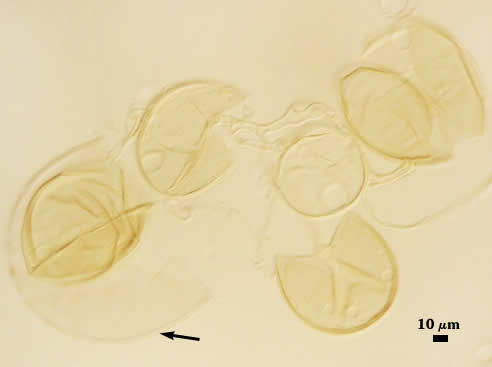Rhizophagus aggregatus
Voucher specimens
This description is a combination of information obtained from the protologue (Koske and Halvorson, 1989), type specimens, and universal patterns of morphological organization shared by all glomoid species.
| Type material in PVLG | From QE102, in PVLG and Melzer's |
|---|---|
|
Sporocarps , when formed, are loose clusters without a peridium, forming both within and outside of roots, 200-1800×200-1400 µm in size from 5-month-old pot cultures and the field, hyaline to pale yellow in color.
Spores globose, obovate, to irregular in shape, 40-120µm in diameter, hyaline to pale yellow in color. They are formed singly or in sporocarps, and freely in soil or in colonized roots.
The spore wall is reported to consist of 1-2 layers (L1, L2), suggesting some pleomorphy in number of layers synthesized. Each layer is 1-3 µm thick (widest at subtending hypha), and pale yellow to yellow-brown in color.
The subtending hyphae usually is single but occasionally double, straight or either flared or constricted, sometimes recurved (basically anything goes) at the point of attachment, pale yellow-brown in color, and 4-10 µm wide at the spore base usually but up to 12 µm wide when flared. The hyphal wall consists of one or both layers of the spore wall (depending on if spore has 1-2 layers). The hyphal pore usually is open, sometimes closed by a thin septum, thickening of the spore wall, or a cytoplasmic plug.
Notes
We agree with a number of researchers who have encountered this species in the field and question whether the fungus is simply a small variant of Rhizophagus intraradices. In the accession QE102 (pictured above), spores initially were classified as R. aggregatus, until spores began to form with an additional outer hyaline layer that is typical of R. intraradices. Over time, the culture contained a mixture of spore phenotypes intergrading between the two species, but we see this transition occurring within the same aggregate of spores and hyphae. Virtually every culture accessed in the collection labelled as G. aggregatum (sensu lato) eventually was reclassified as R. intraradices. It is noteworthy that within the boundary conditions of the species, R. intraradices, there is considerable variation in spore size, color, and abundance of layers in the spore wall, such as that observed for R. irregularis. These traits are interrelated, with smaller spores having fewer layers and being lighter in color.
Reference
- Koske, R. E. 1985. Glomus aggregatum emended: A distinct taxon in the Glomus fasciculatum complex. Mycologia 77:619-630.
- Schenck, N. C. and G. S. Smith. 1982. Additional new and unreported species of mycorrhizal fungi (Endogonaceae) from Florida. Mycologia 74:77-92.

